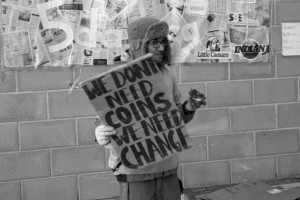by Maria Gebhardt
Homelessness in America is an epidemic that affects over 500,000 people on any given night with 7 million additional individuals living with friends or family due to lack of housing (The State of Homelessness in America, 2016). Average costs of homelessness to society can vary, depending on location and available services, but they are steadily reported to be tens of thousands of dollars per year, per person. HUD officials have stated that homeless individuals cost taxpayers as much as $40,000 each, per year; this figure includes transitional or emergency housing, jail visits, emergency room visits, and mental health care (S. Donovan, personal communication, March 5, 2012). Just knowing over half a million Americans don’t have a place to sleep at night is troubling enough, but the fact that we, as tax payers, spend so much money keeping them homeless is disgraceful.
What if I told you it is cheaper to give all the homeless families and individuals homes? One would think that anyone with a shred of humanity or fiscal knowledge would jump on the opportunity to better the lives of hundreds of thousands of people, help make them contributing members of society AND save millions of dollars per year; the problem is, not everyone is. Some efforts have been made but much greater change needs to occur.
The formula for drastically reducing chronic homelessness is simple, give them homes first then help them sustain them. An approach originating in New York- Housing First- does just that and it works. Housing First is an approach to fight homelessness using a fairly simple method: quickly and effectively connect individuals with permanent housing without barriers such as mental health, addiction, etc., with a lease contract and additional services offered on a voluntary basis. Essentially, the approach focuses on housing individuals first then addressing the factors that potentially caused the individual or family to become homeless and helping them form a path to maintain permanent housing.
Housing First has provided substantial reductions in the homeless population in several areas of the country and, most drastically, in Utah. Using the Housing First approach, Utah reduced their chronically homeless population by an outstanding 91%; spending only $10,000-$12,000 a year per individual (Mcevers, 2015). These numbers make one wonder why more cities are not jumping on board the Housing First movement.
Some speculation of Utah’s success has been noted concerning government official’s rush to declare homelessness solved and the inaccuracies that occur while trying to record homeless individuals. Even through these speculations, it is obvious that they have put forth a sincere effort and that effort is paying off both humanely and financially. The numbers of chronically homeless individuals are being reduced and the taxpayers are spending less money; those two facts cannot be debated.
Simply put, Housing First works. Utah is saving over $10,000 a year, per person while housing those who did not have permanent housing before. Denver, CO, using the Housing First approach, is saving over $2.4 million annually and has reported that over 80% of the individuals in the program have maintained permanent housing for 6 months or more (Denver Housing First, 2006). Charlotte, NC reported a $1.8 million savings its first year using the Housing First approach for just 85 individuals (Miles, 2014).
These numbers are astonishing not only because of the monetary savings but the number of lives changed through Housing First. This all leads to the overbearing question: Why are we paying so much money to keep the homeless, homeless?
I urge you to visit endhomelessness.org to learn about Housing First efforts in your area and ways you can help. #uml #commpsych
Maria Gebhardt is a graduate student in the Community Social Psychology department at the University of Massachusetts Lowell.
References
Denver Housing First Collaborative Cost Benefit Analysis & Program Outcomes Report. (2006, December). Retrieved from http://www.coloradocoalition.org/!userfiles/housing/ executive_summary_dhfc_study.pdf
La Ganga, Maria L. Utah says it won ‘war on homelessness’, but shelters tell a different story. (2016, April 27). Retrieved from https://www.theguardian.com/us-news/2016/apr/27/utah-homeless-shelters-housing-first
Mcevers, Kelly. Utah Reduced Chronic Homelessness By 91 Percent; Here’s How. (2015, December 10). Retrieved from http://www.npr.org/2015/12/10/459100751/utah-reduced-chronic-homelessness-by-91-percent-heres-how
Miles, Kathleen. Housing The Homeless Not Only Saves Lives — It’s Actually Cheaper Than Doing Nothing. (2014, March 25) Retrieved from http://www.huffingtonpost.com/2014/03/25/housing-first-homeless-charlotte_n_5022628.html
The State of Homelessness in America. (2016, April 6). Retrieved from http://www.endhomelessness.org/library/entry/SOH2016





